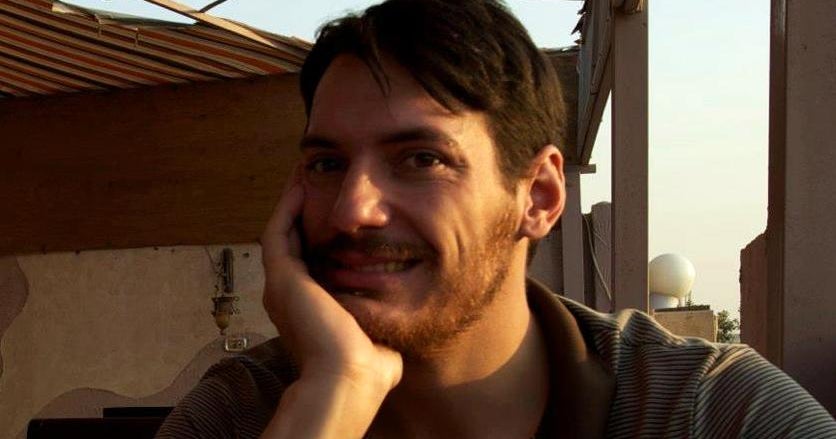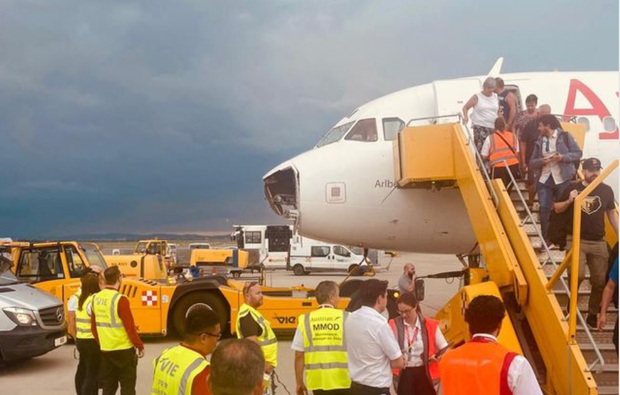CBS News
It only takes 5 seconds of hail to damage an airplane mid-flight, expert says. Photos show how destructive it can be.

An Austrian Airlines flight went viral this week after it flew through a hailstorm on Sunday that ripped off part of the plane’s nose and shattered its cockpit windows. And one expert tells CBS News that while incidents like this are rare, they can happen very easily — and very fast.
The incident involved Austrian Airlines flight OS434, en route from Palma de Mallorca to Vienna, the airline told CBS News. As seen in photos shared by passengers and passersby, the airline also confirmed that the two front cockpit windows and the aircraft nose, also known as the radome, were damaged, as well as “some coverings.” An investigation is now underway.
Anonymous via Storyful
“Due to the damage, a Mayday distress call was made,” an airline spokesperson said. “The aircraft was able to land safely at Vienna-Schwechat Airport. All passengers on the flight were unharmed.”
The spokesperson also confirmed that “the incident lasted only a few seconds.” According to meteorologist Renny Vandewege, general manager of weather and climate intelligence at DTN, that’s all it takes to cause damage.
He told CBS News that “because of an airplane’s high speed, hail doesn’t have to be all that large to wield damage to an aircraft.”
“The radome, at the nose of the plane, is particularly vulnerable because of the thin material used on that part of the plane,” he said. “Because of the aircraft speed, only as little as a 5-second exposure to a hail shaft can shatter noses and cockpit windows.”
Anonymous via Storyful
However, he added that few airplanes ever get caught in hail shafts because of the onboard radar systems. In most situations, these kinds of weather systems are avoided, he said.
Austrian Airlines told CBS News that Sunday’s situation happened after the plane encountered a thunderstorm cell while it was approaching Vienna, and that “according to the cockpit crew, [it] was not visible on the weather radar.” Single-cell thunderstorms, according to NOAA’s National Severe Storms Laboratory, are “small, brief, weak storms that grow and die within an hour or so” and are known to produce brief heavy rain and lightning.
It’s the thunderstorm core where things can be particularly dangerous, Vandewege said, as that’s where the updraft is at a maximum.
“It is the input of the energy source of the storm originating at the surface where the storm ingests warm moist air,” he said. “…These updrafts are what enables storms to produce hail because they can circulate ice up and down with the storm until it is too heavy to circulate. Therefore, the storms with the strongest updrafts can produce the largest hail.”
Anonymous via Storyful
As global temperatures rise, so does the frequency and intensity of extreme weather, including thunderstorms. And while flying through hail can quickly become damaging, Vandewege said that it doesn’t mean flying isn’t safe.
He told CBS News that building materials “are ever evolving” to make aircraft “lighter and tougher,” and that the information and technology used to avoid hail shafts is also undergoing substantial advancement.
“Of course, keeping your seatbelt on, light or not, is also recommended,” he said. “…Considering the level of advancement of avoidance technology, I don’t think there is any more reason to fear safety from thunderstorms than before. In fact, the past was more dangerous from relying on weaker technology for avoidance.”
CBS News
Biden’s top hostage envoy Roger Carstens in Syria to ask for help in finding Austin Tice

Roger Carstens, the Biden administration’s top official for freeing Americans held overseas, on Friday arrived in Damascus, Syria, for a high-risk mission: making the first known face-to-face contact with the caretaker government and asking for help finding missing American journalist Austin Tice.
Tice was kidnapped in Syria 12 years ago during the civil war and brutal reign of now-deposed Syrian dictator Bashar al-Assad. For years, U.S. officials have said they do not know with certainty whether Tice is still alive, where he is being held or by whom.
The State Department’s top diplomat for the Middle East, Barbara Leaf, assistant secretary of state for Near Eastern Affairs, accompanied Carstens to Damascus as a gesture of broader outreach to Hay’at Tahrir al-Sham, known as HTS, the rebel group that recently overthrew Assad’s regime and is emerging as a leading power.
Near East Senior Adviser Daniel Rubinstein was also with the delegation. They are the first American diplomats to visit Damascus in over a decade, according to a State Department spokesperson.
They plan to meet with HTS representatives to discuss transition principles endorsed by the U.S. and regional partners in Aqaba, Jordan, the spokesperson said. Secretary of State Antony Blinken traveled to Aqaba last week to meet with Middle East leaders and discuss the situation in Syria.
While finding and freeing Tice and other American citizens who disappeared under the Assad regime is the ultimate goal, U.S. officials are downplaying expectations of a breakthrough on this trip. Multiple sources told CBS News that Carstens and Leaf’s intent is to convey U.S. interests to senior HTS leaders, and learn anything they can about Tice.
Rubinstein will lead the U.S. diplomacy in Syria, engaging directly with the Syrian people and key parties in Syria, the State Department spokesperson added.
Diplomatic outreach to HTS comes in a volatile, war-torn region at an uncertain moment. Two sources even compared the potential danger to the expeditionary diplomacy practiced by the late U.S. Ambassador Christopher Stevens, who led outreach to rebels in Benghazi, Libya, in 2012 and was killed in a terrorist attack on a U.S. diplomatic compound and intelligence post.
U.S. special operations forces known as JSOC provided security for the delegation as they traveled by vehicle across the Jordanian border and on the road to Damascus. The convoy was given assurances by HTS that it would be granted safe passage while in Syria, but there remains a threat of attacks by other terrorist groups, including ISIS.
CBS News withheld publication of this story for security concerns at the State Department’s request.
Sending high-level American diplomats to Damascus represents a significant step in reopening U.S.-Syria relations following the fall of the Assad regime less than two weeks ago. Operations at the U.S. embassy in Damascus have been suspended since 2012, shortly after the Assad regime brutally repressed an uprising that became a 14-year civil war and spawned 13 million Syrians to flee the country in one of the largest humanitarian disasters in the world.
The U.S. formally designated HTS, which had ties to al Qaeda, as a foreign terrorist organization in 2018. Its leader, Mohammed al Jolani, was designated as a terrorist by the US in 2013 and prior to that served time in a US prison in Iraq.
Since toppling Assad, HTS has publicly signaled interest in a new more moderate trajectory. Al Jolani even shed his nom de guerre and now uses his legal name, Ahmed al-Sharaa.
U.S. sanctions on HTS linked to those terrorist designations complicate outreach somewhat, but they haven’t prevented American officials from making direct contact with HTS at the direction of President Biden. Blinken recently confirmed that U.S. officials were in touch with HTS representatives prior to Carstens and Leaf’s visit.
“We’ve heard positive statements coming from Mr. Jolani, the leader of HTS,” Blinken told Bloomberg News on Thursday. “But what everyone is focused on is what’s actually happening on the ground, what are they doing? Are they working to build a transition in Syria that brings everyone in?”
In that same interview, Blinken also seemed to dangle the possibility that the U.S. could help lift sanctions on HTS and its leader imposed by the United Nations, if HTS builds what he called an inclusive nonsectarian government and eventually holds elections. The Biden administration is not expected to lift the U.S. terrorist designation before the end of the president’s term on January 20th.
Pentagon spokesperson Pat Ryder disclosed Thursday that the U.S. currently has approximately 2,000 US troops inside of Syria as part of the mission to defeat ISIS, a far higher number than the 900 troops the Biden administration had previously acknowledged. There are at least five U.S. military bases in the north and south of the country.
The Biden administration is concerned that thousands of ISIS prisoners held at a camp known as al-Hol could be freed. It is currently guarded by the Syrian Democratic forces, Kurdish allies of the U.S. who are wary of the newly-powerful HTS. The situation on the ground is rapidly changing since Russia and Iran withdrew military support from the Assad regime, which has reset the balance of power. Turkey, which has been a sometimes problematic U.S. ally, has been a conduit to HTS and is emerging as a power broker.
A high-risk mission like this is unusual for the typically risk averse Biden administration, which has exercised consistently restrained diplomacy. Blinken approved Carstens and Leaf’s trip and relevant congressional leaders were briefed on it days ago.
“I think it’s important to have direct communication, it’s important to speak as clearly as possible, to listen, to make sure that we understand as best we can where they’re going and where they want to go,” Blinken said Thursday.
At a news conference in Moscow Thursday, Russian President Vladimir Putin said he had not yet met with Assad, who fled to Russia when his regime fell earlier this month. Putin added that he would ask Assad about Austin Tice when they do meet.
Tice, a Marine Corps veteran, worked for multiple news organizations including CBS News.
CBS News
12/19: CBS Evening News – CBS News

Watch CBS News
Be the first to know
Get browser notifications for breaking news, live events, and exclusive reporting.
CBS News
Delivering Tomorrow: talabat’s Evolution in the Middle East

Watch CBS News
Be the first to know
Get browser notifications for breaking news, live events, and exclusive reporting.











